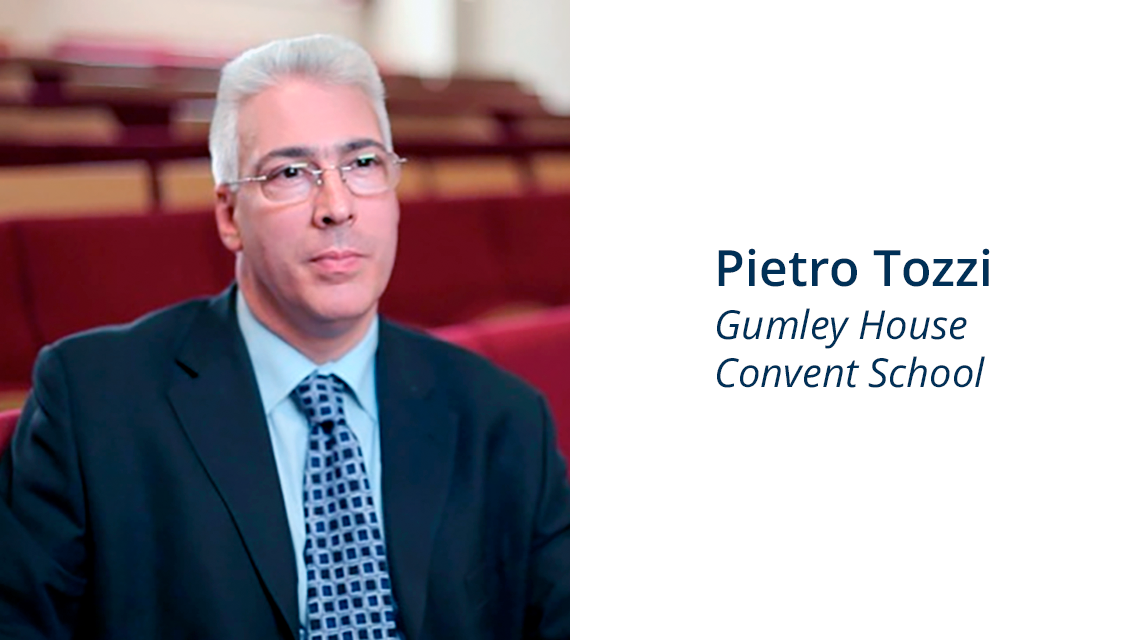Pearson Edexcel GCSEs Mathematics (9–1) from 2015 Gumley House School

Gumley House School
Stepping up to the GCSE (9-1) Maths challenge brings great results
| Name | Gumley House School | ||
| Type | Comprehensive, Church School | ||
| Location | Isleworth, Middlesex | ||
| Cohort | GCSE Maths cohort size: 180 | Cohort EAL: 36% | Cohort SEN: 14% |
Background
Gumley House School is a comprehensive church school for girls aged 11-18 and has been a Pearson collaborative hub school since 2012. Like many schools, Gumley House was facing fresh challenges in teaching for the new GCSE (9-1) Mathematics exams.

Pietro Tozzi, Maths Teacher, explains the approach they took to overcome the initial hurdles and deliver positive outcomes of the summer exams.
The GCSE (9-1) learning curve
The introduction of the new GCSE (9-1) Maths exams brought a whole new set of challenges for both teachers and students. Not only was there a change in topics and emphasis, but it was also assumed that there would be prior knowledge from KS2 and KS3 which was missing from the first few cohorts. There were also some topics at the top end of the specification which some teachers did not have any experience of teaching.
How restructuring our curriculum helped address the increase in expectations
To address the new set of challenges we moved to a three-year KS4. This gave us more time to deliver the additional content, concentrate on problem-solving and give time for assessments and intervention. We also built in additional training and sharing of resources for new topics and teaching methods such as 'Bar Models'.
Having moved to a two-year KS3, we used the Pearson two-year scheme of work and embraced the suite of Pearson KS3 Maths Progress resources. Initially some students found these schemes quite difficult but ultimately it was the necessary building blocks required to introduce them to the new more demanding GCSE (9-1).
Motivating and progressing Year 10 and 11 students
We put in several steps to help students through the new process. Following the Pearson scheme of work, we used Formative Assessments at the end of each Unit and also used the End of Term / Year Tests as baselines in which to adjust the setting of students who were borderline between the Higher and Foundation sets. We also developed a mapping to give the 'Progression Steps' into new GCSE (9-1) subgrades, so students could see if they were on target.
We ran a twice weekly Maths Clinic to support students, who came voluntarily or by invitation following poor homework or test results, for immediate intervention. For Year 11 we did the same as Year 10 but we also ran intervention classes during tutor times for students who were in danger of not achieving their personal target grade which we determined using FFT Aspire.
Training and practice helped to build student confidence
The new tests helped us with problem-solving in terms of the type of questions we set. We also had some Bar Model training we delivered during INSET day and also used the problem-solving papers produced by Pearson. Some staff used the Gold, Silver and Bronze papers which provided different levels of scaffolding to help students develop the confidence to tackle problems independently. We used the Access to Foundation write in textbooks for some of our weakest learners in Year 9.
We did two mocks using Pearson secure papers in December and April, and in the weeks leading up to the mocks we gave out the Pearson practice papers. We found the performance data table at the end of each practice paper most useful as it showed what percentage of students succeeded in every question when it was used in a previous live paper.
The grade boundaries were originally difficult to gauge as there were no live paper boundaries to go by at that time but it is much easier this year. We really think the key things that helped the students were putting them in control of their own learning and ensuring the teachers supported students by being flexible and approachable.
Saving time so teachers could teach
We also received excellent support from Edexcel. The Maths Emporium emails informed us of changes and new resources, Collaborative Networks, plus Graham's Emporium with all the resources in one place. It saved us hours, since all the materials mentioned were prepared for use with our classes.
Summer exams and key learnings
Once the exams came round we found they were less demanding than mocks 1 and 2. Nevertheless, there was a big leap in difficulty from the legacy specs but we knew that would be the case. Looking at the analysis released by the Edexcel Maths team (available from the Mathematics Emporium), it was many of the 'basics' which held back some of the students. Although 'Problem-Solving' is important, some of the performance data showed that students still made mistakes with such things as percentages, constructions and transformations. Also we need to make sure they know their formulae, particularly the Higher Tier, as there was evidence of students not being able to recall them fluently. Mastery is certainly a key focus for us next year
The outcome – hard work and determination delivers good exam results
The new GCSE (9-1) has been challenging for both teachers and students. The expectations were so much higher but we were able to introduce essential steps to tackle this. We knew it would be tough but we got through it with determination and hard work. We are immensely proud of our students and our final results whereby 81% achieved Grade 4-9 and 22% achieved Grades 7-9.